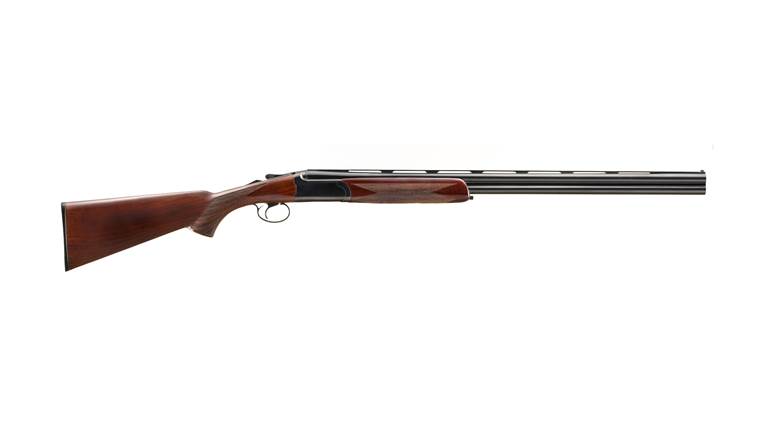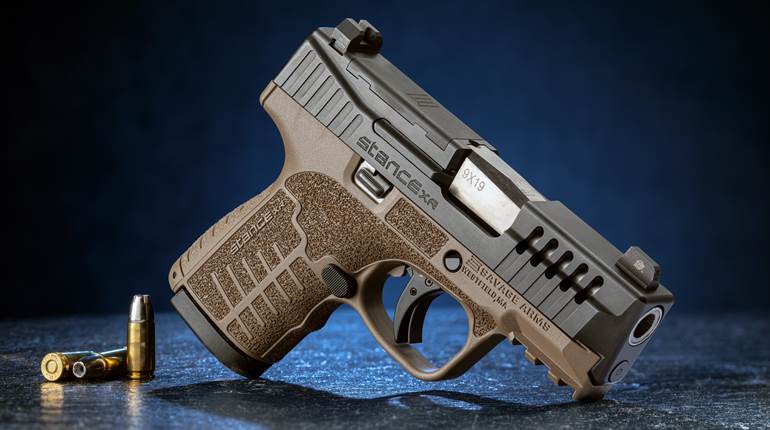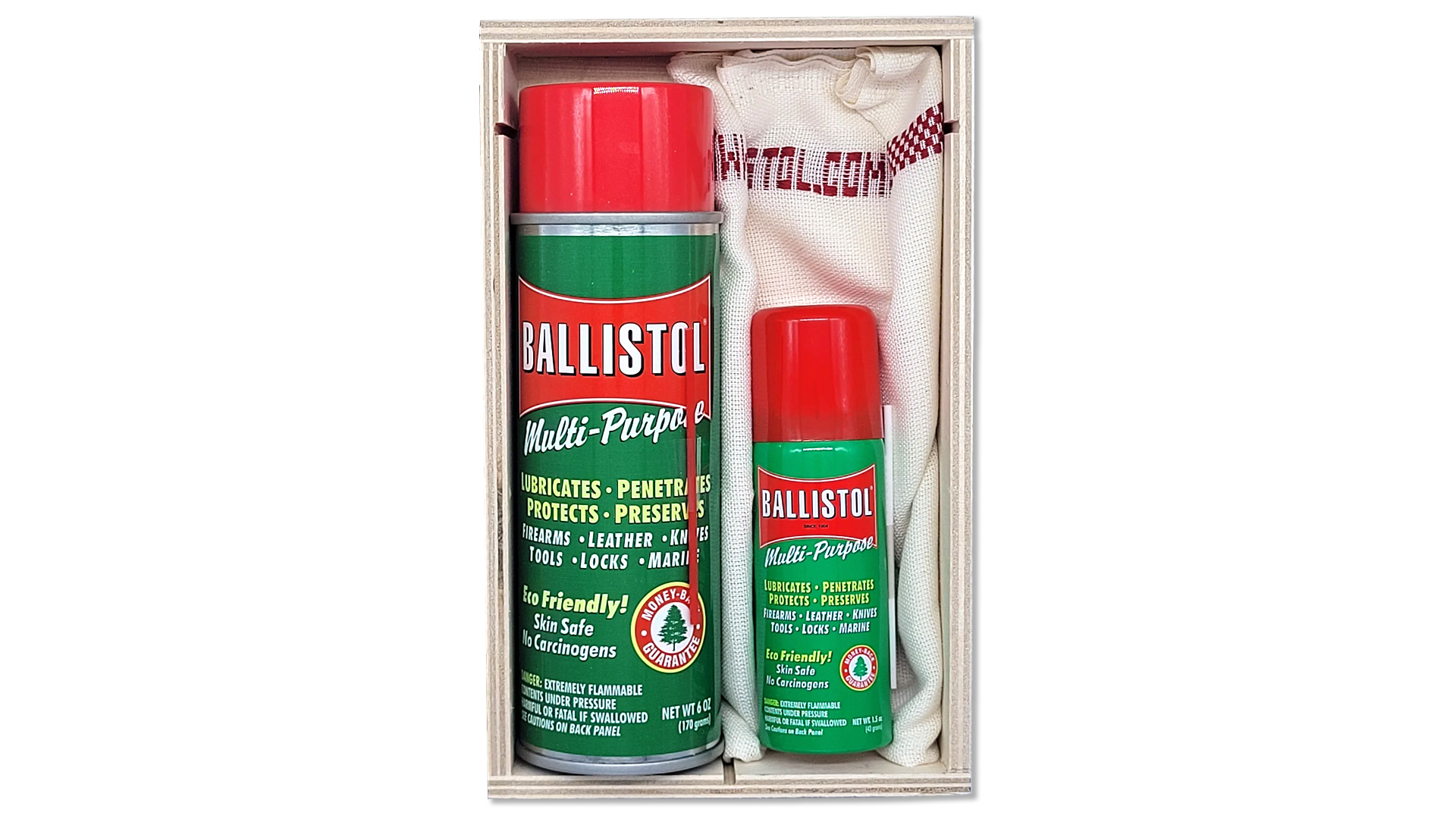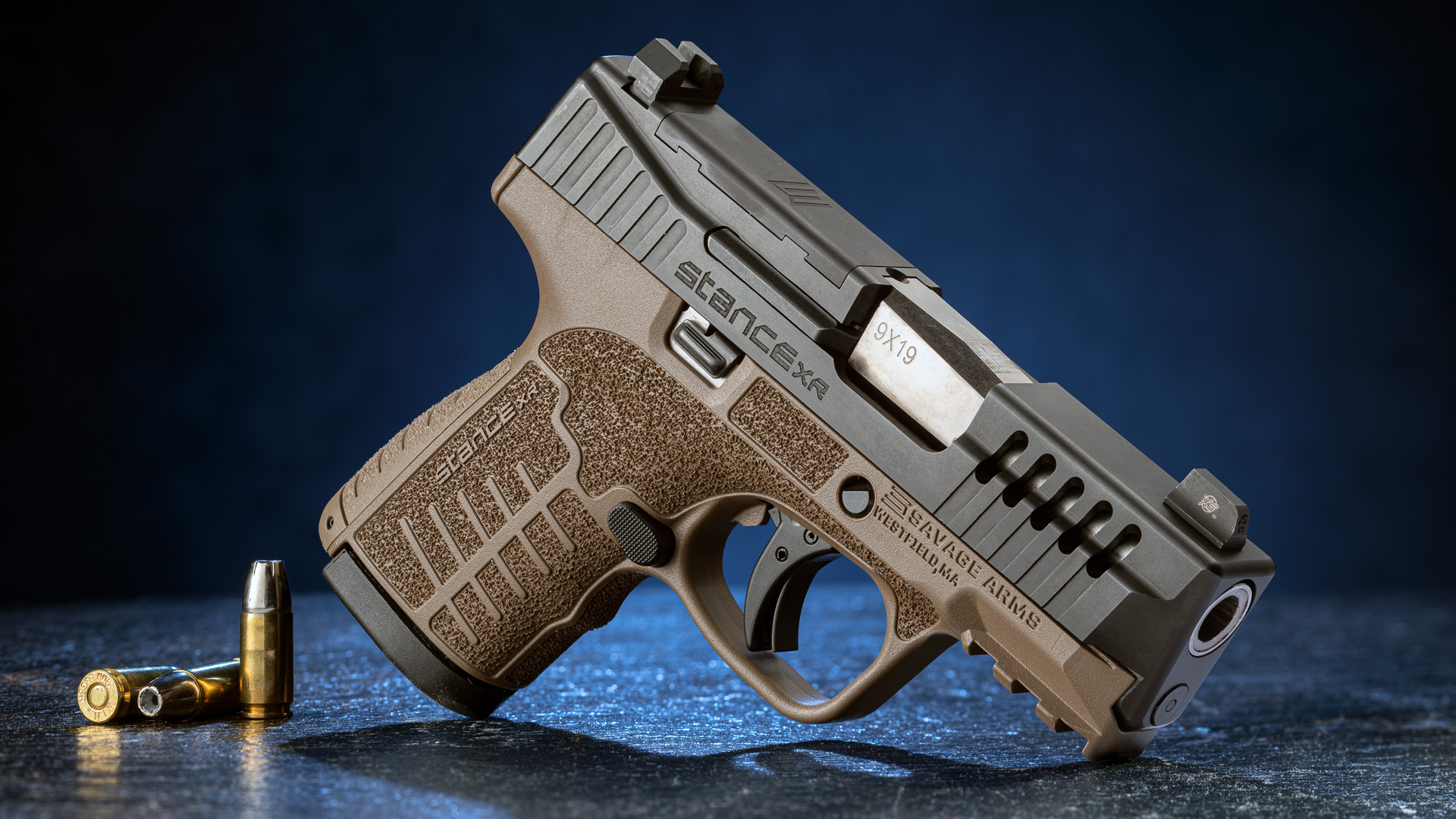
During the latter part of the 19th century, it was not uncommon for cowboys to pack both a single-action revolver and a lever-action carbine—each chambered for the same ammunition. Back then, that typically meant a rimmed cartridge such as .44-40 Win. carried on gun belts and bandoleers. It was an eminently sensible system by virtue of the fact that it simplified the user’s ammunition supply.
Nearly 150 years later, the concept still makes a lot of sense, depending on the circumstances, especially since most defensive firearms now feed from convenient detachable-box magazines. That development alone has simultaneously revolutionized the carriage of extra ammunition and the quick reloading of firearms. Previously, fine motor skills and ingrained muscle memory were required to successfully pluck those rimmed cartridges singly from their leather loops and shove them, one by one, into chambers or tubular magazines—often while under pressure. And while it’s true that some 21st century shooters still enjoy the nostalgia such guns recall—a point not lost on Ruger, which still offers many single-action revolver models—most of today’s buyers are more interested in modern guns designed for personal defense. That is a point of which the company is also keenly aware.
Two such models that exemplify that conviction are entirely new designs, yet were somewhat informed by ground the company plowed in the not-too-distant past. The first is a pistol-caliber, semi-automatic long gun chambered in 9 mm Luger and appropriately labeled as the PC Carbine, and the second is a like-chambered compact, semi-automatic pistol called the Security-9. Both names are evocative of past Rugers that enjoyed success among scores of shooters. One, the Ruger Police Carbine (February 1997, p. 40.), was chambered in either 9 mm Luger or .40 S&W and shared magazines with like-chambered pistols from the firm’s original P Series. The other, the Security-Six revolver (January 1985, p. 26), was also, coincidentally, manufactured in 9 mm Luger using full-moon clips, although the bulk of its production was in
.38 Spl. and .357 Mag.
But as with all families, any similarity in name is often more than made up for by a disparity in traits. And so it is with the latest Rugers. Whereas the former Police Carbine was compatible only with magazines from the company’s sole line of extant center-fire pistols, the new PC Carbine accepts magazines from three current Ruger pistol lines: the SR Series and Security-9—which, curiously, are not interchangeable between their host pistols—and the American. Even more compelling, the PC Carbine is also capable of being fed from the now-ubiquitous Glock-pattern magazine. And since the new Security-9 pistol is, of course, fed from a detachable-box magazine (in its case, one holding 15 rounds), it allows for quicker reloads than any revolver—even one using moon clips.
What the two newest Rugers really share, though, is the company’s strength of bringing together the latest in manufacturing technology, features and design to optimize firearms for their intended purposes—in these cases, keeping law-abiding armed citizens safe from the deadly threats inherent to modern life. Whether its engineers accomplished their specific goals in designing and building the PC Carbine and Security-9 should become clear after careful consideration of the separate reviews that follow.

The Ruger PC Carbine
By Brian C. Sheetz, Senior Executive Editor
The pistol-caliber carbine concept seems either to attract or repel depending on how those considering it perceive such a gun’s role. Detractors question why someone would want an arm with the bulk and weight of a rifle but possessed of only a pistol’s power. Looking at it from the opposite position, however, supporters suggest that such a carbine’s longer barrel enhances the velocity, and, thus, energy and lethality of most handgun cartridges. Also, being a shoulder-mounted arm with diminished recoil compared to true rifles, and having a longer sight radius than a pistol—not to mention accommodations for red-dot or magnified optics—make it far easier for most shooters to score hits with than any handgun. Its lesser recoil also increases its ability to make accurate repeat shots rapidly—all of which makes it potentially easier to master by a greater range of users. In any case, it’s probably best to see the pistol-caliber carbine not as a rifle replacement, but as a pistol force-multiplier.
Ruger’s latest take on the concept, the PC Carbine, wisely applies several notable improvements to the company’s previous effort. For one, the PC’s method of operation, like its predecessor, is fundamentally a blowback design, though the mechanism is much improved and greatly simplified. In addition, the PC borrows from Ruger’s phenomenally successful Model 10/22 semi-automatic rimfire carbine not only in some aspects of its general layout, and even in a few specific trigger group components, but, most notably, in its mimicking of the Takedown version’s ability to be quickly and easily separated into two compact sections. Perhaps most importantly, in terms of its market appeal, the PC, with a simple swapping out of magazine well inserts, can be quickly converted to accept Glock-pattern 9 mm Luger magazines, including that company’s own 33-round example originally developed for the G18 machine pistol. Finally, as with its companion pistol reviewed below, the PC Carbine is priced to attract—essential in an era of $450 AR-type rifles—with a suggested retail of $649 that is likely to translate to over-the-counter figures in the high $400s.
The gun is not as high-tech in appearance as most other currently offered pistol-caliber carbines, which tend to be based either on unique designs or on adaptations of the AR. Its buttstock and fore-end are molded from 33 percent glass-filled nylon into a fusion of traditional and modern lines. The butt is capped with a rubber recoil pad and spacer system borrowed from the company’s Gunsite Scout Rifle. It has a molded-in sling swivel stud and stippling in panels on either side of the pistol grip, which also features slight palm swells. Further, the buttstock forms the magazine well, which houses a large, serrated, metal magazine release button that can be installed on either side. Internally, the release engages Ruger magazines at a rectangular cutout in the front center of their bodies. Two action screws secure the receiver to the stock. They pass through imbedded brass inserts that prevent their falling free when the receiver is removed.
Once the receiver is free, either of the Ruger magazine well inserts, one of which is marked on its mouth “SR9 S9” and the other “RA9,” or the Glock magazine insert, marked “G9”, can be dropped into place within the magazine well as the magazine release is pressed. As the receiver is reinserted into the buttstock, and the action screws tightened to 65 in.-lbs., the insert is clamped firmly in position. It’s worth noting here that Ruger advises that some Magpul Glock-pattern magazines may not function reliably with the PC Carbine. Factory Glock magazines, however, have been found to function well, as have some other aftermarket offerings, including 50- and 100-round drum designs.
The gun is taken down for transport or storage in identical manner to that of the 10/22 Takedown. A recess in the lower front of the buttstock guides the thumb into position to retract a downward-protruding pin in the fore-end assembly. That allows the fore-end to be twisted and the barrel pulled free of the receiver. The buttstock and fore-end assemblies measure 193/4" and 165⁄16" in overall length, respectively, and the latter, which also has panels of stippling on its sides, has a molded-in section of accessory rail for the attachment of a light or laser at its lower front just ahead of a metal QD sling stud.

At first glance, the PC Carbine’s receiver, bolt assembly and trigger group appear similar to those used in the 10/22. The PC’s receiver is machined from aluminum bar stock and is closed at the rear while its bottom and front are open. It is finished in a flat-black hard-anodized treatment. An integrally machined, 61/2"-long, 16-slot section of Picatinny rail runs along the receiver’s top surface, and machined openings in its sides include an ejection port on the right and keyways on the right and left for the bolt carrier’s hollow charging handle, which can be swapped by way of a single screw running through its center. Two sets of holes through each side of the receiver at its rear act as attachment points for pins that secure the polymer fire-control housing, which contains a crossbolt safety in the trigger guard’s front and a blade-type bolt catch immediately in front of the trigger guard that is pressed upward to hold the bolt to the rear. Finally, a steel barrel block is attached by way of machine screws at the receiver’s front. It features the recesses that accept a set of lugs machined onto the barrel’s breech end when the barrel assembly is turned into place during assembly. (There is also a knurled ring that can be adjusted to ensure the joint assembles without excess play.)
A bolt carrier measuring approximately 1.125" square by 4.5" inches in length rides below a guide rod and a “bolt top” keyed to the bolt. While fundamentally a blowback, the gun’s design also relies on a separate so-called dead-blow weight, mimicking the function of a like-named hammer. The weight measures 0.750" square by 1.875" in length and is metal-injection-molded from tungsten—an elemental metal with a density 1.7 times that of lead. According to Ruger engineers, the weight accounts for nearly half of the bolt assembly’s mass, which keeps its overall size reasonable yet still allows the mechanism to counteract the recoil of even 9 mm Luger +P cartridges. The weight rests in a pocket machined into the bolt carrier that allows about 0.025" of play fore and aft, and, in operation, comes to rest a split second after the carrier, retarding the carrier’s velocity somewhat as it changes direction. That helps prevent the “bolt bounce” effect often associated with such guns, which can result in receiver battering and a lack of reliability. It also softens the blow of the carrier against the receiver somewhat, even though that task is primarily handled by a elastomer buffer attached to the rear of the recoil spring assembly.
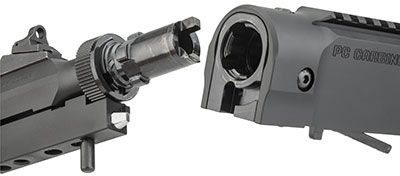
The PC Carbine’s 16 5⁄16" barrel is tapered and fluted, which helps to keep the gun’s weight centered between the hands, making it less muzzle-heavy than its predecessor, which housed a slide assembly and counterweight in its fore-end. The muzzle is threaded 1/2"x28 TPI. and capped with a polymer O-ring and knurled steel thread protector. Steel sights—a fully adjustable ghost-ring rear and a wing-protected blade front—are secured to the barrel with screws and provide a sight picture similar to that of the U.S. M14 and M1 Garand rifles. Future plans call for an optic plate that would replace the rear sight assembly to allow mounting of a reflex sight directly to the barrel.
At 6 lbs., 10 ozs., the PC Carbine has a substantial feel, but its weight is centered between the hands, and the gun comes to the shoulder readily—its iron sights aligning well with the eye when the stock meets the shooter’s face. Beyond resulting in better balance, the new carbine’s design facilitates the take-down configuration since the action’s moving parts are confined to the buttstock assembly.
A recent Ruger-sponsored media event at Gunsite Academy in Paulden, Ariz., provided ample opportunity for about a dozen writers to put a sampling of the new carbines through their paces. In the course of running several thousand rounds through the guns in exercises designed to simulate dynamic engagements, the PC Carbine proved its mettle, with all the guns exhibiting excellent reliability and commendable accuracy.
Back at NRA Headquarters, other editors were favorably impressed with the gun’s handling qualities. Accuracy results, as tabulated in the accompanying table, were achieved using a Trijicon AccuPoint 1.25-4X 24 mm scope set at 4X. Comparing velocity and energy figures of the Hornady Critical Defense Lite 100-gr. FTX load fired from the PC Carbine with corresponding results from the Security-9 pistol (p. 76), demonstrate that, on average, the PC Carbine’s longer barrel added 221 f.p.s. and 117 ft.-lbs. of energy at the muzzle—a 17 percent increase in velocity and a 31 percent increase in energy. In addition, the new NovX 65-gr. polymer matrix load in the PC Carbine achieved 2031 f.p.s. and 595 ft.-lbs. of energy—a 36 percent increase in velocity and a 37 percent increase in energy compared to the Hornady load.

For anyone who concedes that the pistol-caliber carbine concept is valid and who can envision how one might complement a personal inventory of firearms, Ruger’s PC Carbine must be acknowledged as one of the better modern examples. Its take-down feature and multi-magazine adaptability provide a utility that every modern-day armed citizen should at least consider as he or she traverses the 21st century frontier.
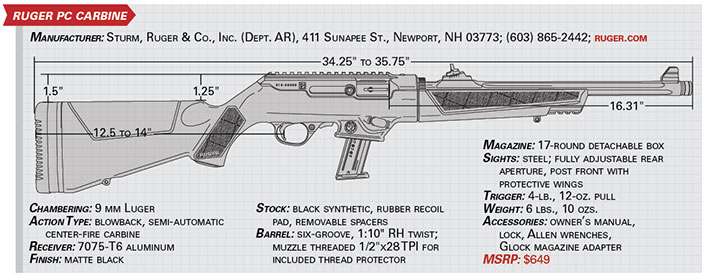

The Ruger Security-9 Pistol
By B. Gil Horman, Field Editor
During the last few years, Ruger has kept its 9 mm Luger semi-automatic pistol fans well armed with the double-stack American and American Compact, designed for uniformed users and protection-minded citizens, and the svelte single-stack LC9s for daily concealed carry. As popular as these two options have been, Ruger recognized that an intermediate option that splits the difference between these two was missing from the lineup.
Ruger’s new Security-9, a compact, polymer-frame, double-stack 9 mm Luger intended primarily for civilian applications, including every-day carry, home defense, target shooting and casual plinking. It weighs nearly 7 ozs. less than the American, while providing double the ammunition capacity of the LC9s. The suggested retail price of $379 is likely to translate into real-world prices closer to $300.
The new Security-9 pistol takes its design cues, inside and out, from the pocket-size LCP II .380 ACP. Imagine an LCP II on steroids, and you’ll have the right idea. This pistol is a pre-cocked, hammer-fired double-action with a passive trigger safety and Browning-type, tilting-barrel lock-up. The recessed hammer, much like the strikers in striker-fired models, is cocked most of the way back by the rearward motion of the slide. Depressing the trigger completes the hammer’s cocking cycle to fire the gun.
The dovetailed polymer sight system consists of a white-dot blade in front and a low-profile, white-outline rear notch unit that is secured by a screw. Both are drift-adjustable for windage. The blued, through-hardened carbon steel slide is milled with angled front and rear cocking serrations. The muzzle end and top edges are cut with angular bevels, while the back of the slide has a rounded, no-snag profile. The enlarged ejection port sports a heavy duty extractor claw.
The blued 4" barrel is cut with traditional land-and-groove rifling with a witness hole located at the top rear of the barrel hood for the purpose of confirming whether a round is in the chamber. The recoil assembly consists of a flat-wire spring captured on a steel guide rod.
Removing the slide reveals a one-piece machined and hard-anodized aluminum chassis pinned within the polymer grip frame and secured to the frame by two polymer pins. Much like the lower receiver of an AR-15 rifle, the Security-9’s chassis is the serialized receiver proper. The number is visible through a window molded into the right side of the frame. The chassis houses most of the moving parts, including the fire-control system and external controls to prevent wear and tear on the polymer frame. Its 4.15"-long slide rails provide greater support for the slide assembly than the small steel inserts used in other designs.

The take-down pin, slide stop, thumb safety and magazine release are all on the left side of the frame. Each has been minimized for comfortable concealed carry. The small slide lock is protected by fencing molded into the frame. It is exceptionally tight when engaging the slide and, therefore, not a practical option for releasing the slide from the locked-open position. It’s a much simpler proposition to pull back on the slide to release it.
The thumb safety is by far the smallest I’ve seen on a pistol in this size class. Nevertheless, it’s relatively easy to manually locate and press down into the “fire” position. The steel magazine release is smooth-faced and diminutive in size, but remains easy to find and operate. It allows the magazines to drop free of the magazine well when depressed.
The black polymer frame is constructed of a durable, long-fiber, glass-reinforced nylon that has proven to be a reliable material in other Ruger models. The dustcover is molded with a 1.5"-long, four-slot accessory rail. The generous, squared-off trigger guard has a textured finger rest along the front edge and an overtravel stop for the trigger. It has been undercut where it meets the grip frame for added comfort.
Grip frame indentations, located behind the trigger housing, provide easier access to the trigger and magazine release. The frontstrap, sides and backstrap of the grip have a molded-in, semi-coarse texturing that mimics skateboard tape without being as abrasive. This texturing provides positive purchase but does not require gloves for long shooting sessions. The base of the backstrap has a short extension that protects the shooting hand from being pinched by the magazine baseplate.
The smooth-faced polymer trigger is listed as having a pull weight of 6 lbs. The pistol I tested exhibited a 5-lb., 5-oz. pull with a bit of take-up before a fairly clean break. The trigger reset is short, with an audible and tangible click. The trigger pull has a shorter, smoother and lighter feel than those found on many of the striker-fired pistols I have used that incorporate passive trigger safeties.
The blued-steel, 15-round magazines are proprietary to the Security-9 pistol. They are not interchangeable with magazines from the company’s other platforms because of differences in feed angles. Manufactured by Ruger here in the United States, the magazines are fitted with polymer followers and baseplates, the latter being textured along the sides to match a pair of textured indentations located on either side of the magazine well. This allows the magazine base to be firmly gripped and stripped out of the gun in case of a malfunction.
A good deal of engineering effort has gone into designing a pre-cocked hammer ignition system for this pistol that provides a smooth trigger pull while operating in a safe and reliable manner. The thumb safety has two functions when set in the “safe” position: It blocks the rotation of the sear, to keep it in firm contact with the hammer, and it blocks the movement of the hammer.
The geometry of the hammer and sear were designed with a significant degree of engagement for a positive lockup when the safety is set in the “fire” position. The sear has a neutral balance while under strong spring tension. This works to prevent disengagement if the pistol is dropped. In the unlikely event that the pistol should receive a significant enough physical shock to disengage the partially cocked hammer from the sear, a hammer catch acts to prevent the hammer from moving into contact with the firing pin unless the trigger is fully depressed.
The trigger’s inner safety lever is another component that works to prevent unintentional discharges. It also acts as an inertial block. Lastly, a lightweight titanium firing pin is paired with a strong return spring. The lighter pin requires a blow from the hammer to move forward with enough force to fire a chambered cartridge. Dropping the gun on a hard surface does not provide enough directed energy to move the firing pin. The Security-9 does not have a magazine disconnect safety and will fire if the trigger is pressed while the magazine is removed.
Fieldstripping the Security-9 is a simple process that does not require the trigger to be cycled, though a tool is required. Begin by removing the magazine and verifying the chamber is empty. From the closed position, push the slide back about 1/16" to align the notch in the slide with the takedown pin. Using the rim of a spent 9 mm case, or similar tool, gently pry the takedown pin out the frame. Press the slide forward off the frame and then lift the barrel and recoil-spring assembly out of the slide. The pistol is now ready to clean.
The Security-9 is safety-rated for all SAAMI specification ammunition, including +P loads. However, a steady diet of +P ammunition is going to cause the pistol to wear out much more quickly than standard-pressure ammunition. If you plan to shoot with +P loads most of the time, then the folks at Ruger recommend purchasing a duty-grade American Pistol instead. If you plan to practice with +P loads occasionally and carry them for personal protection, then the Security-9 will do nicely. This gun should not be loaded with +P+ ammunition at any time.
Overall, the Security-9 offers an impressive, well-balanced package of features for a pistol at this price point. At the shooting range, it ran reliably with all of the ammunition tested without any failures. The fit and finish are on par with more expensive polymer-frame Ruger pistols. The pistol feels light and well-balanced in the hand, all the controls worked properly, the slide cycles smoothly, and the sights are easy to see. Like other lightweight 9 mm pistols, the Security-9 can produce a snappy level of felt recoil with some loads. Nonetheless, the grip is just the right size to properly manage the diverse selection of 9 mm loads available.

This pistol arrives ready to serve as a first-time gun purchase, a comfortable daily carry gun and as an affordable trunk or camp gun that won’t cause bitter tears to be shed if it picks up a scratch or two along the way. And Ruger already offers a wide variety of high-quality holsters, magazine pouches and sight upgrades for it at the shopruger.com website.














